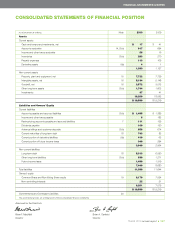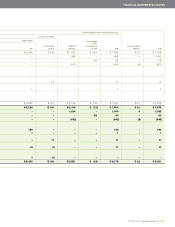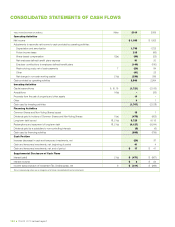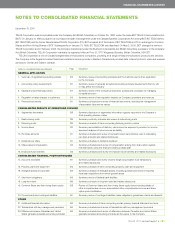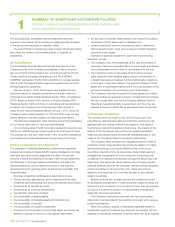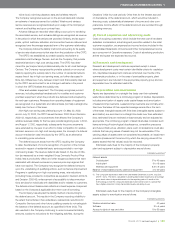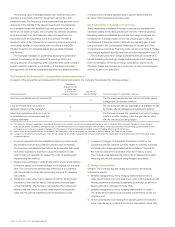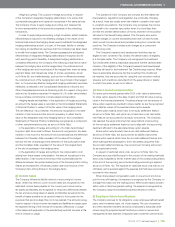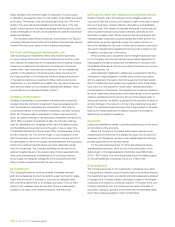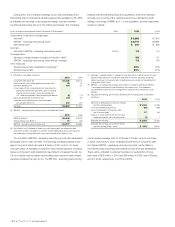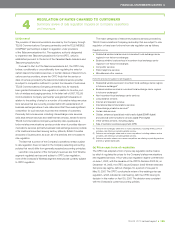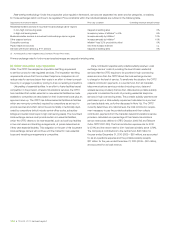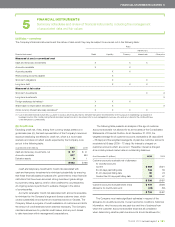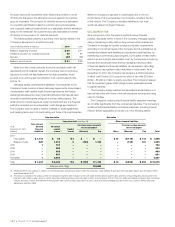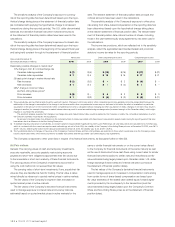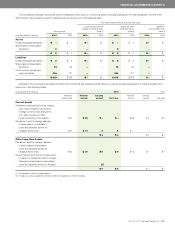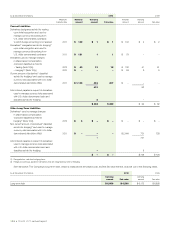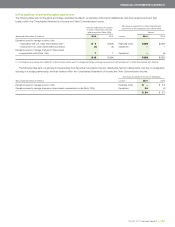Telus 2010 Annual Report Download - page 131
Download and view the complete annual report
Please find page 131 of the 2010 Telus annual report below. You can navigate through the pages in the report by either clicking on the pages listed below, or by using the keyword search tool below to find specific information within the annual report.
TELUS 2010 annual report . 127
FINANCIAL STATEMENTS & NOTES: 2–3
included in the Consolidated Statements of Income and Other Compre-
hensive Income as a component of other comprehensive income. When
there is an other than temporary decline in the value of the investment, the
carrying values of investments accounted for using the equity, available-
for-sale and cost methods are reduced to estimated fair values with such
reduction being included in the Consolidated Statements of Income and
Other Comprehensive Income as Other expense, net.
(s) Comparative amounts
Certain of the comparative amounts have been reclassified to conform to
the presentation adopted currently.
The Company accounts for its other investments as available-for-
sale at their fair values unless the investment securities do not have
quoted market prices in an active market, in which case the Company
uses the cost basis of accounting whereby investments are initially
recorded at cost and earnings from such investments are recognized
only to the extent received or receivable. The cost of investments sold
or amounts reclassified out of other comprehensive income into earnings
are determined on a specific identification basis.
Unless there is an other than temporary decline in the value of an
available-for-sale investment, carrying values for available-for-sale invest-
ments are adjusted to estimated fair values with such adjustment being
Standards as issued by the International Accounting Standards
Board (IFRS-IASB) over a transitional period to be complete by 2011.
The Company will be required to report using the converged standards
effective for interim and annual financial statements relating to fiscal
years beginning no later than on or after January 1, 2011, the date which
the Company has selected for adoption.
Convergence with International Financial
Reporting Standards as issued by the International
Accounting Standards Board
In 2006, Canada’s Accounting Standards Board ratified a strategic
plan that will result in Canadian GAAP, as used by publicly accountable
enterprises, being fully converged with International Financial Reporting
2ACCOUNTING POLICY DEVELOPMENTS
Summary review of generally accepted accounting principle developments
that do, will, or may, affect the Company
Net debt to EBITDA – excluding restructuring costs is calculated as
net debt at the end of the period divided by twelve-month trailing EBITDA
– excluding restructuring costs. Net debt is a measure that does not
have any standardized meaning prescribed by GAAP and is therefore
unlikely to be comparable to similar measures presented by other
issuers; the calculation of net debt is as set out in the following schedule.
Net debt is one component of a ratio used to determine compliance
with debt covenants. The calculation of EBITDA – excluding restructuring
costs is a measure that does not have any standardized meaning pre-
scribed by GAAP and is therefore unlikely to be comparable to similar
measures presented by other issuers; the calculation of EBITDA –
excluding restructuring costs is as set out in the following schedule.
This measure, historically, is substantially the same as the leverage
ratio covenant in the Company’s credit facilities.
The reported dividend payout ratio is calculated as the quarterly
dividend declared per Common Share and Non-Voting Share, as
recorded in the financial statements, multiplied by four and divided by
the sum of basic earnings per share for the most recent four quarters
for interim reporting periods (divided by annual basic earnings per
share for fiscal years); the reported dividend payout ratio of adjusted
net earnings differs in that it excludes: income tax-related adjustments;
the loss on redemption of long-term debt; and the ongoing impacts
of the share options with the net-cash settlement feature.
The Company’s objectives when managing capital are: (i) to maintain
a flexible capital structure that optimizes the cost of capital at acceptable
risk; and (ii) to manage capital in a manner that considers the interests
of equity and debt holders.
In the management of capital, the Company includes Common
Share and Non-Voting Share equity (excluding accumulated other com-
prehensive income), long-term debt (including any associated hedging
assets or liabilities, net of amounts recognized in accumulated other
comprehensive income), cash and temporary investments and securitized
accounts receivable in the definition of capital.
The Company manages the capital structure and makes adjustments
to it in the light of changes in economic conditions and the risk charac-
teristics of the underlying assets. In order to maintain or adjust the capital
structure, the Company may adjust the amount of dividends paid to
holders of Common Shares and Non-Voting Shares, purchase shares for
cancellation pursuant to permitted normal course issuer bids, issue new
shares, issue new debt, issue new debt to replace existing debt with
different characteristics and/or increase or decrease the amount of sales
of trade receivables to an arm’s-length securitization trust.
The Company monitors capital on a number of bases, including: net
debt to Earnings Before Interest, Taxes, Depreciation and Amortization –
excluding restructuring costs (EBITDA – excluding restructuring costs);
and dividend payout ratios.
3CAPITAL STRUCTURE FINANCIAL POLICIES
Summary review of the Company’s objectives, policies and processes
for managing its capital structure


